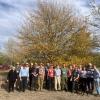Editor's Picks
Plant Focus
Biodiversity conservation assessment to protect two micro-endemic oaks from western Mexico: Quercus cualensis and Q. tuitensis
Poster presented at the XX International Botanical Conference, Madrid, Spain, July 21–27, 2024.
Authors:
Maribel Arenas-Navarro1,2, Jhenifer Reyes-Galvez2, Javier Piña-Torres3, Andrés Torres-Miranda2
Affiliations:
1. Facultad de Estudios Superiores Iztacala, Universidad Nacional Autónoma de México, México, México
2. Escuela Nacional de Estudios Superiores Unidad Morelia, Universidad Nacional Autónoma de México, Michoacán, México
3. Red de Biología Evolutiva, Instituto de Ecología A.C., Xalapa, México
Abstract:
Oaks are recognized as a key species and play vital ecological roles across several ecosystems. In Mexico, oaks mainly inhabit temperate forests, although they can also be found in scrublands, dry forests, and humid tropical mountain forests. In western ranges from Mexico (Jalisco), at least 30 oak species have been recorded, considered a high richness and endemism center for red oaks (Lobatae section). Quercus cualensis and Q. tuitensis are two micro-endemic species in this region. The 2020 IUCN evaluation classified Q. cualensis as endangered and Q. tuitensis as vulnerable. However, neither species is protected under Mexico's standard norms, leaving them vulnerable to threats like deforestation, land use change, and climate change. The main objective of this study was to carry out a risk assessment method through the robust analysis of its current distribution (ecological niche modeling) and their projection to different climate change scenarios (optimistic and pessimistic), along with intrinsic and anthropogenic threats. This analysis will facilitate its inclusion in the Mexican standard norms. As a result, the risk method analysis determined that both species are in danger of extinction due to the reduced habitat and recent anthropogenic pressures such as the reactivation of an old gold mine and the illegal extraction of pine wood in the forests. These two species have very small distribution areas (between 125 - 154 km2), and with the climate change models, they reduced their environmental suitability by 100 % in pessimistic scenarios, even though these species inhabit different environments but with very narrow tolerance ranges. As a first step into conservation actions, we established educational strategies in the local schools with kids and adults about the importance of endemic species in the region, the importance of preserving species with local knowledge, and a legal framework to achieve their long-term protection.
















